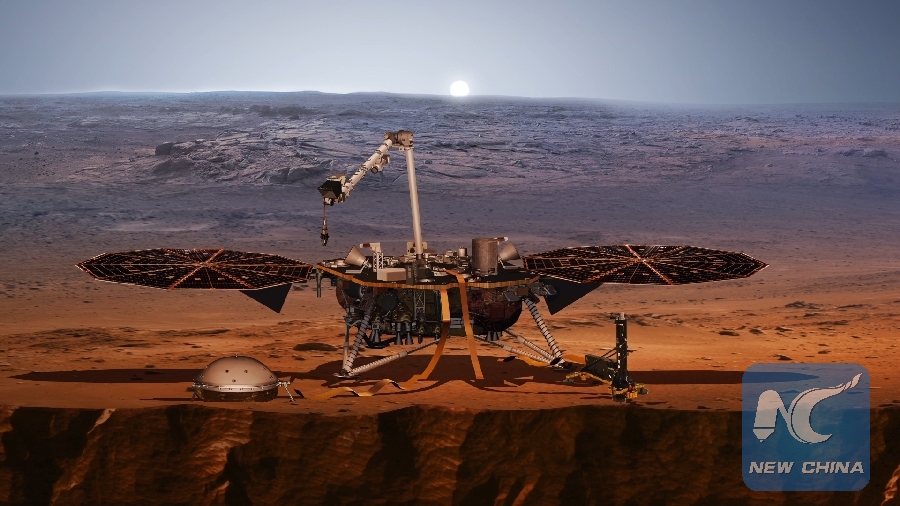
This artist's concept depicts the InSight lander on Mars after the lander's robotic arm has deployed a seismometer and a heat probe directly onto the ground. (Credit:NASA/JPL-Caltech)
by Tan Jingjing
LOS ANGELES, April 23 (Xinhua) -- After several months of waiting on a quiet surface, NASA's InSight lander has measured and recorded a small but sweet sound: the first likely "marsquake".
"Mars, I hear you. I've detected some quiet but distinct shaking on #Mars," tweeted NASA InSight on Tuesday.
The faint seismic signal, detected by the lander's Seismic Experiment for Interior Structure (SEIS) instrument, was recorded on April 6, the lander's 128th Martian day.
This is the first recorded tremor that appears to have come from inside the planet, as opposed to being caused by forces above the surface, such as wind, according to NASA.
Scientists are still examining the data to determine the exact cause of the signal.
A video and audio clip were posted on the NASA website, illustrating the seismic event recorded by InSight's SEIS. The instrument measured three distinct events, namely, Martian wind, Marsquake and the spacecraft's robotic arm as it moves to take pictures.
The audio was produced from two sets of sensors on the SEIS. According to the mission team, audio from both sets of sensors has been sped up by a factor of 60. The actual vibrations on Mars would not have been audible to the human ear.
Three other seismic signals that occurred on March 14, April 10 and April 11 have also been detected by SEIS' more sensitive Very Broad Band sensors.
These signals were even smaller than the April 6 Marsquake and more ambiguous in origin. The team will continue to study these events to try to determine their cause, according to NASA.
"We've been collecting background noise up until now, but this first event officially kicks off a new field: Martian seismology," said InSight Principal Investigator Bruce Banerdt of NASA's Jet Propulsion Laboratory in Pasadena, California.
The new seismic event was too small to provide solid data on the Martian interior, which is one of InSight's main objectives, according to the mission team.
The Martian surface is extremely quiet, allowing SEIS to pick up faint rumbles. In contrast, Earth's surface is quivering constantly from seismic noise created by oceans and weather, according to NASA.
"We've been waiting months for a signal like this," said Philippe Lognonne, SEIS team lead at the Institut de Physique du Globe de Paris (IPGP) in France.
"It's so exciting to finally have proof that Mars is still seismically active," said Lognonne. "We're looking forward to sharing detailed results once we've had a chance to analyze them."
According to NASA, detecting these tiny quakes required a huge feat of engineering. On Earth, high-quality seismometers often are sealed in underground vaults to isolate them from changes in temperature and weather.
InSight's instrument has several ingenious insulating barriers, including a cover built by NASA's Jet Propulsion Laboratory (JPL) called the Wind and Thermal Shield, to protect it from the planet's extreme temperature changes and high winds.
"InSight's first readings carry on the science that began with the Apollo missions," Banerdt said.
NASA's Apollo astronauts installed five seismometers that measured thousands of quakes while operating on the Moon between 1969 and 1977, allowing scientists to use these waves to learn about the interior of the Moon and model its formation, according to NASA.
NASA currently is planning to return astronauts to the Moon by 2024, laying the foundation for future human exploration of Mars.
The SEIS, which InSight placed on the planet's surface on Dec. 19 last year, will enable scientists to gather similar data about Mars. By studying the deep interior of Mars, they hope to learn how other rocky worlds, including Earth and the Moon, formed.
InSight, the first mission to explore Mars' deep interior, landed in the Elysium Planitia of Mars on Nov. 26, 2018. It will investigate processes that shaped the rocky planets of the inner solar system more than 4 billion years ago.

